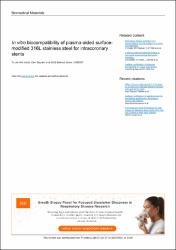In vitro biocompatibility of plasma-aided surface-modified 316L stainless steel for intracoronary stents

Göster/
Tarih
2010Yazar
Bayram, CemMızrak, Alpay Koray
Aktürk, Selçuk
Kursaklioglu, Hurkan
Iyisoy, Atila
Ifran, Ahmet
Denkbas, Emir Baki
Üst veri
Tüm öğe kaydını gösterÖzet
316L-type stainless steel is a raw material mostly used for manufacturing metallic coronary stents. The purpose of this study was to examine the chemical, wettability, cytotoxic and haemocompatibility properties of 316L stainless steel stents which were modified by plasma polymerization. Six different polymeric compounds, polyethylene glycol, 2-hydroxyethyl methacrylate, ethylenediamine, acrylic acid, hexamethyldisilane and hexamethyldisiloxane, were used in a radio frequency glow discharge plasma polymerization system. As a model antiproliferative drug, mitomycin-C was chosen for covalent coupling onto the stent surface. Modified SS 316L stents were characterized by water contact angle measurements (goniometer) and x-ray photoelectron spectroscopy. C1s binding energies showed a good correlation with the literature. Haemocompatibility tests of coated SS 316L stents showed significant latency (t-test, p < 0.05) with respect to SS 316L and control groups in each test.

















